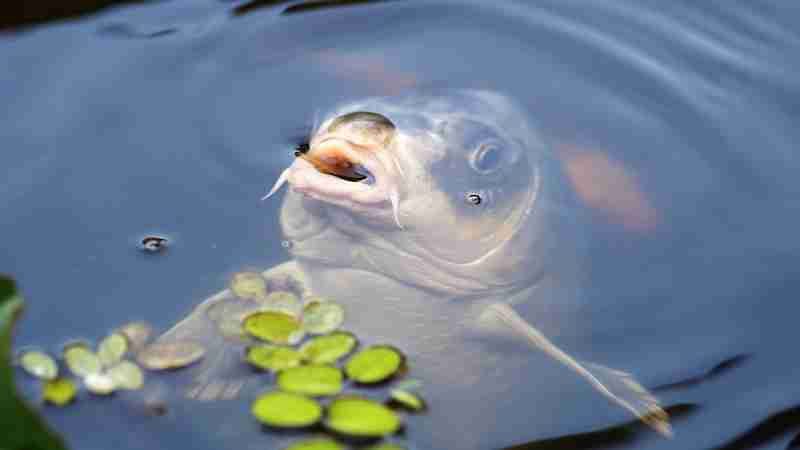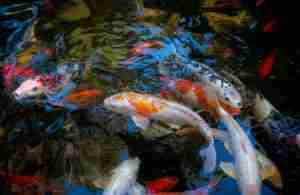A pond is a perfect home for aquatic life. To make sure your fish, amphibians, and other creatures remain healthy, you need to make sure pond oxygen levels are at an optimal level.
The concentration of dissolved oxygen in ponds not only impacts the health of inhabitants but also determines which species can live in it. Low levels cause stress that may eventually lead to death.
When there is sufficient oxygen in a pond, the fish will continue to swim and eagerly consume food. Fish will be more active and reproduce more quickly, which helps to maintain a healthy balance in the ecosystem. A pond with sufficient oxygen levels should not cloud over. The pond’s surface should be clean and clear.
What causes low oxygen levels in ponds? The oxygen demand on each pond will vary depending on factors such as its size, temperature, water movement, and the amount of organic matter it contains.
Runoff containing pollutants, such as fertilizers and sewage can lower the oxygen level of a pond. Keep reading to learn how to tell if your pond has low oxygen levels and what you can do to help improve them.
What Are Some of the Common Signs of Low Oxygen in Ponds?
 Algae problems, such as green water or an excessive accumulation of plant material, may also be indicative of low levels of oxygen. Various factors can lead to oxygen depletion in ponds including:
Algae problems, such as green water or an excessive accumulation of plant material, may also be indicative of low levels of oxygen. Various factors can lead to oxygen depletion in ponds including:
- Overpopulation of fish
- Introduction of pollutants into the water
- Lack of circulation of water
A lack of oxygen production due to poor water movement can cause a decrease in the number of beneficial organisms. Such organisms can be tons of bacteria and invertebrates, as well as an increase in pathogenic organisms. In that case, fish and other aquatic animals will die because most of the pond surfaces will be covered with algae.
Can You Test Oxygen Levels in Ponds?
Testing kits are available online or at local pet stores that measure dissolved oxygen content in parts per million (ppm). Testing can be done weekly or monthly, depending on temperature changes and other factors contributing to decreased oxygen levels.
You can purchase a 6-in-1 solution like the API Pond Master Water Test Kit. It contains six test bottles that allow you to measure the phosphate content, pH balance, nitrite levels, ammonia content, and more.
Pour the water and chemical mix into the mixing bottle using the measuring tube that came with your kit. Add yet another tube of water to the sample bottle, and repeat for each of the other test bottles in your kit. You will be able to get an accurate measurement of the various parameters of your water.
Should You Test The Pond Oxygen Concentration Level?
 It’s essential to regularly test the oxygen levels in your pond, as these can change rapidly and without warning. Low oxygen levels can lead to stress, disease, and even death for the creatures in your pond.
It’s essential to regularly test the oxygen levels in your pond, as these can change rapidly and without warning. Low oxygen levels can lead to stress, disease, and even death for the creatures in your pond.
With regular testing, you will be able to identify any potential problems quickly and take steps to rectify them. Changes in water temperature can greatly affect the ability of aquatic organisms to extract oxygen from the water, which can ultimately lead to a decrease in dissolved oxygen content.
How to Keep Enough Oxygen in Your Pond Water
Generally speaking, the higher your pond’s dissolved oxygen content is above 5 ppm (parts per million), the more likely its inhabitants will be healthy and thrive. To maintain this ideal level of dissolved oxygen content, there are several things you must do:
- Circulate water regularly using a pond pump or aerator to ensure the water has enough oxygen.
- Reduce the amount of organic debris in the water, like dead plants or leaves, as they consume oxygen when decomposing.
- Keep a healthy pond environment; too many fish can quickly deplete oxygen levels.
- Add plants to your pond’s ecosystem. Plants help by releasing oxygen into the water during photosynthesis.
- Monitor pH balance; low pH levels cause an increase in dissolved carbon dioxide and less dissolved oxygen concentrations.
The type of pond you plan to create and the type of pond fish you plan to add to your pond determine how much oxygen is needed. For instance, koi ponds require more oxygen than ponds containing aquatic plants.
This type of pond is known for having a large population of fish and therefore requires more oxygen to support life and provide enough breathable air. To ensure your koi pond’s oxygen levels are adequate, you should use an aeration system with supplemental water circulation.
5 Causes of Low Oxygen Levels in Your Pond
Aside from regularly testing your pond’s oxygen levels, some telltale signs may indicate a problem:
#1 Unusual frothy surface on the water
A frothy water surface area results from a large amount of carbon dioxide released into the pond, reducing oxygen levels. Froths or bubbles may also be caused by plant decay or overpopulation of fish.
#2 Fish gasping at the surface of the water
Are your fish swimming close to the water’s surface area and gulping for air? If so, they could be trying to compensate for low oxygen levels. This can indicate distress and should be addressed as quickly as possible.
#3 Discoloration or suffocation of aquatic plants
One of the main components of water is oxygen; without enough, aquatic plants will start to die off or display signs of distress. If you notice discoloration or the wilting of aquatic plants, it could indicate that your pond has inadequate pond oxygen levels.
#4 Visible signs of stress on fish (lethargy, listlessness)
Lethargy, also known as listlessness, is a visible sign that your fish are in distress. Lethargic fish are not likely to eat or swim around like normal and may start to crowd together in one area of the pond.
For instance, Japanese koi are especially prone to oxygen deprivation and should be monitored closely.
#5 High levels of algae growth
A sudden increase in algae growth can indicate a decrease in oxygen levels. Algae need carbon dioxide to grow and release oxygen as they break it down, so an increase in algae growth may be your pond’s way of getting more oxygen into the water.
By recognizing these warning signs, you can act quickly to restore balance in your pond and keep your aquatic friends safe.
Can You Increase Oxygen Levels in Pond Water?
There are a few ways to add oxygen to your pond. Aeration systems can be used to increase oxygen levels and make sure that the environment does not have excess fish waste. You can also use water pumps or fountains to increase circulation, and waterfalls and streams act as natural aerators.
Finally, adding surface vegetation around the edge of the pond will help provide additional oxygen to the water by absorbing carbon dioxide from the air and releasing oxygen through photosynthesis.
How to Increase Dissolved Oxygen Levels
 Inactive pond aeration and gas exchange are perfect environments for the growth of bothersome algae. Most fish will absorb oxygen from the water as their primary source of sustenance, so low concentrations can be harmful to their health.
Inactive pond aeration and gas exchange are perfect environments for the growth of bothersome algae. Most fish will absorb oxygen from the water as their primary source of sustenance, so low concentrations can be harmful to their health.
If you notice some fish gasping for air, that is an indication that less oxygen is present in the pond than what is required for healthy fish. Here are a few ways to increase it:
Purchase a Pond Air Pump
Air pumps must be physically located outside of the pond, and the length of the airline must run from it to the air stone or diffuser inside the pond. There are plenty of air pumps on the market, so you can choose one that is strong enough to effectively aerate your pond.
Add more pond plants
More oxygenating plants or pond plants that produce oxygen are beneficial for the overall health of your pond. Other plants, like water lilies and floating plants, can also be added to the pond to help absorb some of the nutrient-rich water and help create a more natural environment.
Get some oxygen stones
To add oxygen to your pond naturally, you can also use oxygen stones. Once you have installed such stones, you can instantly notice how tiny bubbles break the surface of a pond when oxygen is released into the water.
Final Words
Ponds are not just visually appealing and instantly add to the aesthetic of your garden, but they are also home to other species. Ensuring that there is enough oxygen in your pond is an essential step towards making sure its inhabitants thrive and remain healthy.
Remember, dissolved oxygen is vital for life in a pond system, and maintaining ideal levels should be one of your top priorities when setting up or managing a pond. By following the steps outlined above, you can ensure that the level of dissolved oxygen content remains at a healthy level for all forms of aquatic life to thrive.
Last Updated on 16/03/2025 by Karen Snow
Hi! I’m Karen and a certified dog lover. As a freelance writer and blogger, I do my best to squeeze in some time with my dogs, learning more about the way they act and how I can make sure that they continue to stay well-cared for by yours truly.
My dogs have helped me through a lot, and this is my way of giving back to them! Besides animals, I also love to travel and cook, having explored my country’s restaurants and unique places. Follow me as I show you all the amazing tips and bits of information I learn along the way about our furry friends!
